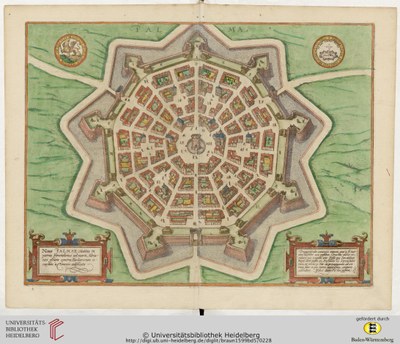Nova Palmae Civitatis – trace italienne
Nova Palmae Civitatis, map, ca. 16th century, unknown artist; source: Georg Braun et al. (ed.): Civitates orbis terrarvm (5): Vrbivm Praecipvarvm Mundi Theatrvm Qvintvm: [Coloni[a]e Agrippin[a]e. 20. die Septemb. Anno M.DC.XVII.] — [Coloniae Agrippinae], [1599?] [VD16 B 7183] [VD17 12:656254M], digital copy: Universitätsbibliothek Heidelberg, Heidelberger historische Bestände – digital, https://digi.ub.uni-heidelberg.de/diglit/braun1599bd5/0228, CC BY-SA 3.0 DE https://creativecommons.org/licenses/by-sa/3.0/de/

